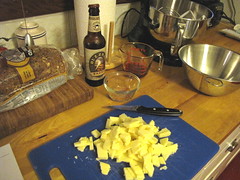
In the comments for the last Welsh rabbit post, reader Lynn wrote:
Do try the rarebit again…it is delicious. I serve it over a bowl of nice bread, cut as for fondue, with steamed broccoli and some nice red bell pepper strips. Quick, pretty inexpensive and really good on a winter night.
Here are my notes: Use a double boiler and cook out the roux first, beat the egg into the beer and thin the roux with this, then melt in the cheese. Foolproof.
We took her advice, using our recipe but her directions. The ingredients were the same, except that we used Buzzsaw Brown Ale instead of Newcastle. We used a metal bowl as a double boiler, and this time the rabbit sauce was dead easy to make and no trouble whatsoever. Lynn was right!
Although we now have a working oven again, I was taking no chances — I just toasted the bread in the toaster this time, playing it safe.
For a side dish, I served a salad with a sweeter balsamic vinaigrette dressing to balance out the salty savoriness of the Welsh rabbit. It worked perfectly.
Kristen wasn’t here that night, and is skeptical that the Welsh rabbit can be good after all, so I’ll be making this again for her to try. The men in the house loved it, though.
The lighting wasn’t great by this time of night (do all the other food bloggers do their cooking in the daytime or something?), but I did get a picture of the finished product:
Compare this with the picture here, and it’s obvious this was a much more successful experiment. Thanks, Lynn!

